
|
|
 |
Main |  |
Projects |  |
Sponsors |  |
Registration |  |
Contact |  |
|
Capstone Graduating Class
ACE Avue Technologies Career Shop CIPS Circuit Analyst MSRM Aquatic Information Branch PureEdge Siemens Thrifty Foods |
Capstone 2003 Projects |
| Presented by the Capstone Graduating Class of 2003 | |

|
|
|
|
|
| Association for Co-operative Eduction | |
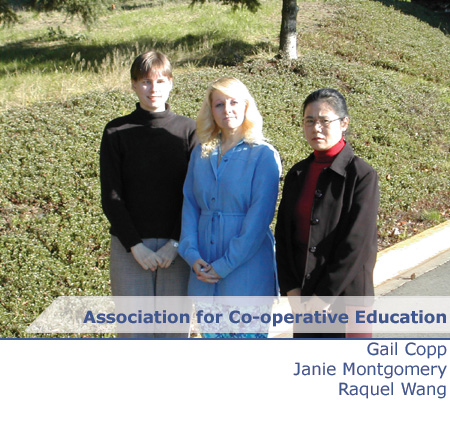
|
|
|
Project: Association for Co-operative Education Website Development Group Members: Gail Copp, Janie Montgomery, Raquel Wang Executive Summary The Association for Co-operative Education is a non-profit organization made up of post-secondary co-op programs throughout BC and the Yukon. ACE promotes co-operative education for students and prospective employers. The Capstone development team consists of Gail Copp, Janie Montgomery and Raquel Wang, all second year students in the Computer Systems Technology program at Camosun College, graduating in December 2003. ACE’s website was in need of an update to handle their current information search and storage needs. The new website involved a total redesign of the existing interface, with the addition of a back-end database. The main benefits associated with the completed project are: improved site navigation, a search feature, additional information to site visitors, innovative interactivity, and online storage of vital association data. Program code was written in the scripting language PHP, which uses an application interface to connect to a MySQL database. Our Capstone team wishes to thank our Project Sponsor, Mr. Brad Erikson, our faculty advisor, Dr. Marla Weston, our Project Manager, Mr. Ken Hartman, and the various other members of the Camosun Computer Systems Technology faculty, who all helped to create an inspiring learning environment while we achieved our Capstone goal. TOP |
|
| Avue Technologies | |
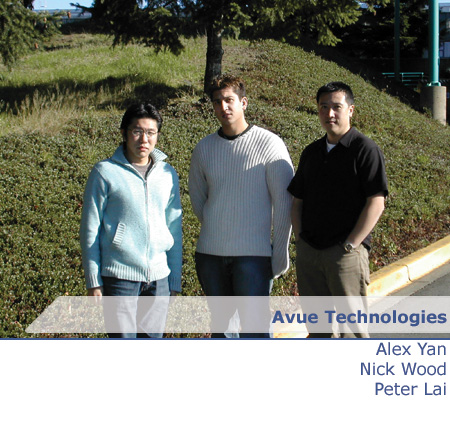
|
|
|
Project: Avue Technologies Smart Card Reader Group Members: Alex Yan, Nick Wood, Peter Lai Executive Summary Avue Technologies is a 15-year-old company that mainly deals with Human Resource departments for numerous United States Federal Government Agencies. Avue creates software that automates the HR management process, enabling HR Professionals and managers in governmental organizations to shift their focus from processing HR paperwork to taking action. Avue's current Applicant Intake System allows users to apply for US Government positions via a web interface or by completing a paper "bubble sheet" that is scanned into the system. Avue would like to investigate adding a third data entry mechanism, a kiosk. The purpose of this project is to implement the connectivity between a smart card reader (using Java Card technology) and the PC-based kiosk, as well as implement changes to Avue's Applicant Intake system to optimize the process for the kiosk environment. The project supervisor, Stephen Curran, will act as the team's liaison and Julia Yan, an employee of Avue Technologies, will act as the team leader on this project. The development team consists of Nick Wood, Peter Lai, and Alexander Yan. Avue will benefit in a number of ways after this project is implemented. First, they will acquire the knowledge of how smart cards function, and how to create software that utilizes them. Next, they will have the ability to market smart cards with systems that they offer subscriptions to. Lastly, they will gain market leverage with US Federal Government Agencies that are purchasing these smart cards. TOP |
|
| Career Shop | |

|
|
|
Project: Career Shop Group Members: Clint Johnson, Kyle Goard, Ryan Graves, Paul Peterson Executive Summary The Career Shop is a youth employment drop-in center that opened in September 1999. They are a career service that offers computer and Internet access, one-on-one counselling, job search strategies, labour market information, education and community resource information and workshops. All of their services are aimed at youth aged 15-30. Their center is fully funded by the government of Canada. The CS team is developing a management system for the Career Shop. The software is written in ASP.NET and C#, and will run on an IIS server with an underlying MySQL database. This management system will encompass multiple modules: Client Sign-in, Case Management, and Administration. Each module which comprises the system has multiple components. The core Case Management module facilitates solutions such as managing clients, real time statistics of system usage, real time Counsellor Reports, and a comprehensive online calendar scheduling system. This management system, along with its management and scheduling modules, will automate tasks which are currently being done manually; resulting in a minimum of 50+ person hours being freed up per month. TOP |
|
| Canadian Information Processing Society | |
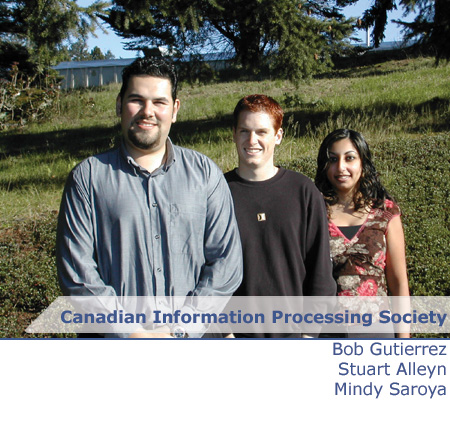
|
|
|
Project: CIPS Website Development Group Members: Bob Gutierrez, Stuart Alleyn, Mindy Saroya Executive Summary The Canadian Information Processing Society, or CIPS, was formed in 1958 as the Computing and Data Processing Society of Canada. The CDPSC was formed to allow data processors to share ideas, knowledge, practices, and technology with each other. In 1968, the organization changed its name to CIPS. CIPS now represents over 8,000 Information Technology (IT) professionals in Canada. The current CIPS website exists mainly as an events calendar and to take registrations for their monthly events, annual golf tournament, and dinners. CIPS believes that their current website has become obsolete, and that by updating to new technologies including content provided on-the-fly by a dynamic front end, the website will better reflect CIPS Victoria as a cutting edge, high technology association. The objective of the website and its function is to offer support, resources, online networking opportunities, and industry information to high school, college, and university students, employees and employers within the local IT community, and a password protected area for the CIPS Victoria executive. The primary goal of the website is to encourage further growth of CIPS Victoria in the form of new members who wish to become a part of the growing CIPS community. CIPS Victoria wants to make their local site a hub for IT professionals and students alike in Victoria, and encourage greater use of the provided online resources. TOP |
|
| Circuit Designer | |

|
|
|
Project: Circuit Analyst Group Members: James Jones, Stephen Harrigan, Adam Woo Executive Summary The Circuit Analyst project was submitted by Dale Shpak to be bundled with future versions of MATLAB. MATLAB is a command prompt program which solves logic and mathematical problems. The target market are engineers. The purpose of Circuit Analyst is to provide a graphical circuit designing interface for electrical engineers. This will allow engineers to graphically connect components and test them without dealing with tedious equations. Upon completion Circuit Analyst will be packaged with MATLAB freely. TOP |
|
| MSRM Aquatic Information Branch | |

|
|
| Project:
Fisheries Data Maintenance Application Group Members: Jeff Dwyer, Andrew Duncan, James Gagan Executive Summary DGD Consultants is a Camosun College Capstone team, consisting of Jeff Dwyer, James Gagan, and Andrew Duncan. We have developed a software project for the Aquatic Information Branch (AIB) of the Ministry of Sustainable Resource Management (MSRM). This project is the Fisheries Data Maintenance Application (FDMA). The project involved the migration of an existing web application to a format that complies with current Ministry standards. This project was necessary because the pre-existing application, which was vital to Ministry biologists, was to be retired within 18 months if not brought up to MSRM application standards. This task entailed redesigning the application and rewriting it completely, utilizing the Jakarta Struts framework, a more modular architecture that will make maintenance of the application much easier. We have also added value to the application by:
Technologies used in development and deployment were: Jakarta Struts 1.0.2, log4j, OC4J Standalone, Oracle RDBMS 9.0.2, JDeveloper, Jakarta Ant, and the Internet Mapping Framework (IMF). The end result is that MSRM now possesses a completed, up-to-date
online data maintenance application, with minimal monetary outlay.
|
|
| PureEdge | |
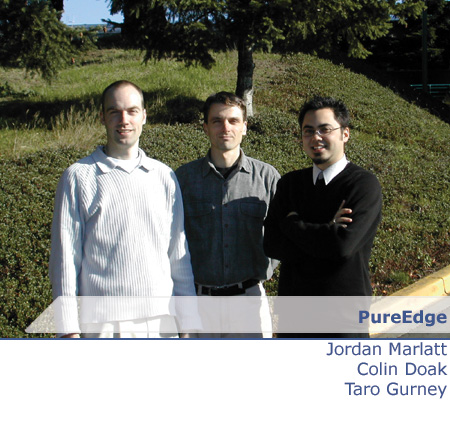
|
|
|
Project: Eisos Plug-in Group Members: Jordan Marlatt, Colin Doak, Taro Gurney Executive Summary The Team: The Eisos Plug-In project team consists of Taro Gurney, Jordan Marlatt and Colin Doak. The faculty advisor is Tim Ayers. The Client: The project is sponsored by PureEdge Solutions, a Victoria-based software development company that specializes in secure XML-based electronic forms. The Project: The Eisos project will involve creating a plug-in for PureEdge’s Designer application. The Designer allows users to create XML-based forms in a graphical environment. The goal of Eisos is to provide a seamless interface between the Designer and a remote repository or Content Management System, and provide file-locking functions. The advantage of this framework is that multiple users will be able to collaboratively design forms without the fear of overwriting shared files. TOP |
|
| Siemens | |
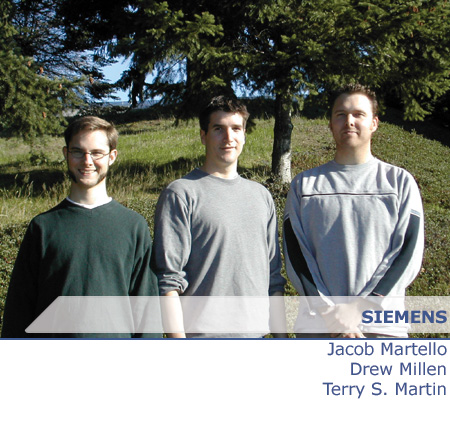
|
|
|
Project: Danger Management Products Approvals System Group Members: Jacob Martello, Drew Millen, Terry S. Martin Executive Summary Siemens is a multinational conglomerate that manufactures and sells a range of products; some of which are Fire and Security products. Because sales representatives sell these products all over the world, they have to ensure that before a product is sold, it has been approved for sale in a country by that countries approval authority. CSA and ULC are two such approval authorities in Canada. Siemens has an application that keeps track of the security products and their approval certificates. Due to the language it is written in, there are limitations to the program. These limitations will cause the application to be retired. Our team has been contracted to rewrite this program using new technology. The new program, "Haven", provides greater speed, improved functionality and better platform independence. The team working on the Haven project consists of three members: Drew Millen, Jacob Martello, and Terry Martin. The application we have created is a web application, developed using a Jakarta Struts framework and a Java Server Pages (JSP) interface. A secondary development goal was to use assisting technologies such as eXtreme Programming, CVS, ant and JUnit. TOP |
|
| Thrifty Foods | |
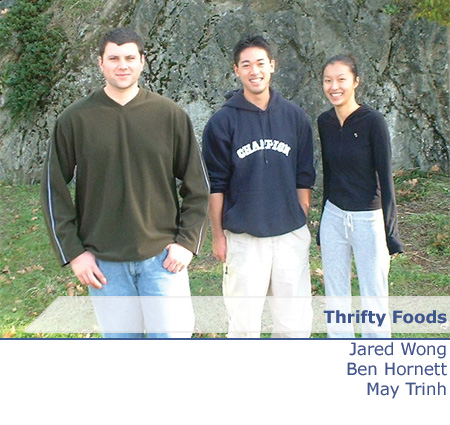
|
|
|
Project: Thrifty Foods Group Members: Ben Hornett, Jared Wong, May Trinh Executive Summary Alex Campbell co-founded Thrifty Foods with one small store in 1977. With a business philosophy of "look after the customers and look after your employees", they have grown into a chain of 18 stores - and they are the largest private-sector employer on Vancouver Island. Thrifty Foods uses a database system to store and keep track of information on customers who submit payment in the form of a cheque. As this database contains important and confidential customer information, Thrifty Foods requires a database system with enhanced security, as well as up to date information. The Thrifty Foods Capstone team of Ben Hornett, Jared Wong and May Trinh are providing Thrifty Foods with an updated non-sufficient funds (NSF) Database Application which includes the following benefits:
TOP |
|
|
|